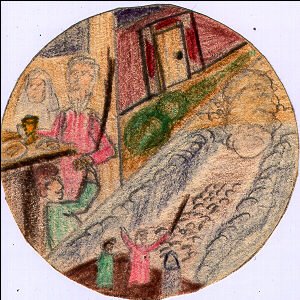Advent: Week 2 Day 7

"And suddenly the Lord Whom you seek shall come to the Temple... But who shall be able to stand when He comes? He shall be like the refiner's fire... He shall sit refining the silver, He will purify the sons of Levi, and refine them as gold and silver..."
Elsewhere we saw (in Jacob's Ladder) Jesus as a civil engineer: the Divine Bridge-Builder. Here we see Jesus as the Divine Metallurgist. In that amazing book from the Middle Ages called The Pirotechnia we can read about how such refining was done, in the days before OSHA and chemistry. It's rather horrifying, even if you have actually seen the real modern technologies for doing metal-working - but it worked. Basically they added a lot of lead to the mix, then boiled off the leadand scraped out the impurities. And they repeated this until the precious metal was pure. That is what the psalms mean about "gold, seven times refined". Remember, the tribe of Levi is the hereditary priesthood of the Israelites. Yes, there are still descendants alive (with names like Lewin, Levandowski, etc) who know their heritage in that family! And we know that Jesus, though of the tribe of Judah (and Son of David) was related somehow to them, for his "cousin" John (the Baptist) was son of Zachariah, who was a priest in the Temple.
But Malachi has far more to say. There is also this mystic vision of the world-wide sacrifice:
"For from the rising of the sun even to the going down, my name is great among the Gentiles, and in every place there is sacrifice, and there is offered to my name a clean oblation: for my name is great among the Gentiles, saith the Lord of hosts."
Here is the announcement of the round-the-clock offering of Holy Mass. Somewhere in the world, Mass is being offered - all the time, everywhere (except, of course, during the Triduum). It's lots better than the INTERNET - you can tap in, even without a modem or a hub/router/switch! Way cool - and unlimited bandwidth, too.
Why are people not connecting Jesus with technology more? He's not just for theologians and philosphers. Indeed - it is not only the theologian or even the philosopher for whom Jesus is the archetype, the exemplar, the model. He inspires the engineer - of all varieties from civil to metallurgical to electronic, the scientist, the laborer (was he not known as the Son of the Carpenter?) and the artist - as well as the writer and the musician. He shows us not only about God, and about truth and thought, but about learning, about doing things well, about making things beautiful AND useful... and, most importantly, about being a good friend - in fact, He exemplifies each and every aspect of being human.
IT SHOULD THEREFORE BE NO SURPRISE THAT CHESTERTON CALLS JESUS CHRIST BY THE TITLE OF "THE EVERLASTING MAN".
"So, therefore, we beseech Thee, Oh Heavenly Father, command that our voices be admitted among the number of the armies of heaven, as they sing without end..."
for
"In every place, there is offered to My Name a clean oblation, for My Name is great among the Gentiles..."










